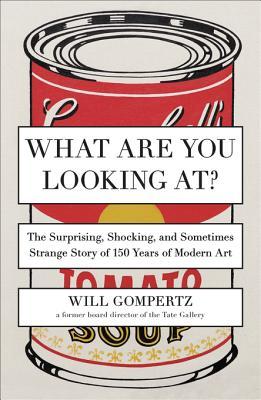
What Are You Looking At?
The Surprising, Shocking, and Sometimes Strange Story of One Hundred Years of Modern Art
کتاب های مرتبط
- اطلاعات
- نقد و بررسی
- دیدگاه کاربران
نقد و بررسی

July 9, 2012
BBC arts editor and former Tate director Gompertz sees a paradox in the contemporary “love affair” with modern art: while people increasingly visit museums such as MOMA and the Pompidou, they often do not fully comprehend what they’re looking at. Gompertz’s aim is to demystify modern art, to provide a basic history of each of its “isms,” and show how these movements are interconnected. Gompertz’s highly lucid, lively, and buoyantly composed history begins with Duchamp’s omnipresent influence on the history of modern art and then chronicles movements that led up to and followed Duchamp’s Fountain (1917), from pre-Impressionist artists Manet and Courbet to contemporary artists Banksy and Ai Weiwei. Gompertz devotes a chapter each to 20 artistic movements, and while his tone is breezy and conversational, he astutely and often wittily describes the core of every movement and its key artists. The result is an entertaining and elucidating guide to modern art, refreshing in its approach and intentions, that will interest the general reader and art enthusiast. B&w art throughout, 8-page color insert.

May 15, 2012
Few of us would have the nerve to do a stand-up show at the Edinburgh Festival Fringe. But BBC arts editor Gompertz does, appearing there in 2009 in a one-man piece called Double Art History, styling himself as a substitute art teacher explaining modern art. That show, a sell-out, bodes well for his new book, which covers the artists, movements, and signal works of modern art while asking some unpretentious questions, e.g., why do we instinctively love or hate it? Former director of Tate Media (as in the wonderful Tate Britain and its wild sister, the Tate Modern) and named one of the world's top 50 creative thinkers by Creativity magazine, Gompertz apparently has an eye for the telling anecdote. A great art history lesson.
Copyright 2012 Library Journal, LLC Used with permission.

Starred review from November 1, 2012
Gompertz succeeds in his stated mission to take a personal, informative, anecdotal, and accessible approach to defining the full spectrum of modern art movements, beginning with impressionism, by portraying the instigating artists and explaining what they were up to and why. A former director of the Tate in London, and currently the arts editor at the BBC, Gompertz is adept at elucidating complex aesthetic ideas and artistic techniques and linking revolutionary art movements to social upheaval (war, communism, the Holocaust) and scientific and technological developments (quantum physics, television, the atom bomb). He revels in the creative, multidisciplinary synergy surrounding such key figures as Monet, Picasso, de Kooning, and Warhol. And he daringly takes a novelist's approach to such foundational acts as Duchamp's purchase of a urinal in New York City in 1917 to create a readymade sculpture that embodied the pivotal realization that if an artist says something is a work of art, it is. Gompertz adeptly divides each broad movement into its intriguing subgroups and includes many more artists, critics, and dealers than the usual suspects. His dissections of performance and conceptual art are uniquely clarifying, and he even coins a keenly apt term for such current provocateurs as Damien Hirst and Jeff Koons: the entrepreneurialists. A deeply enlightening and buoyant history of modern art and beyond.(Reprinted with permission of Booklist, copyright 2012, American Library Association.)

























دیدگاه کاربران